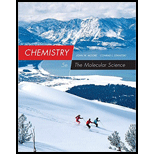
Concept explainers
(a)
Interpretation:
The step for the mass in grams of vitamin C in the tablet is incorrect has to be identified.
Concept introduction:
Number of moles can be calculated by using following formula,
The Molarity of the solution can be calculated by using following formula
(a)
Explanation of Solution
The reaction is shown below,
According to the balanced equation, 1 moles of citric acid (
Step 1:
Given,
Moles of
Step 1 is incorrect answer, because the conversion of mL to litter is missing.
Step 2:
Given,
Moles of
Step is 2 is incorrect because, number of moles of bromine is wrong. Hence Step is 2 is incorrect.
Step 3:
Given,
Moles of
Step is 3 is incorrect because, moles of
Step 4:
Given,
Step is 4 is incorrect because, mass in grams of
Over all, step 1, step 2, step 3 and step 4 are incorrect answer.
(b)
Interpretation:
The correct result has to be determined.
Concept introduction:
Refer to part (a)
(b)
Explanation of Solution
The reaction is shown below,
According to the balanced equation, 1 moles of citric acid (
Moles of
Moles of
The mass of
The correct result is that the mass of
Want to see more full solutions like this?
Chapter 3 Solutions
Bundle: Chemistry: The Molecular Science, 5th, Loose-Leaf + OWLv2 with Quick Prep 24-Months Printed Access Card
- You are given a solid mixture of NaNO2 and NaCl and are asked to analyze it for the amount of NaNO2 present. To do so, you allow the mixture to react with sulfamic acid, HSO3NH2, in water according to the equation NaNO2(aq) + HSO3NH2(aq) NaHSO4(aq) + H2O() + N2(g) What is the weight percentage of NaNO2 in 1.232 g of the solid mixture if reaction with sulfa-mic acid produces 295 mL of dry N2 gas with a pressure of 713 mm Hg at 21.0 C?arrow_forwardAcetic acid (HC2H3O2) can be prepared by the action of the acetobacter organism on dilute solutions of ethanol (C2H5OH). The equation for the reaction is C2H5OH(aq)+O2(g)HC2H3O2(aq)+H2OHow many milliliters of a 12.5% (by volume) solution of ethanol are required to produce 175 mL of 0.664 M acetic acid? (Densityofpureethanol=0.789g/mL.)arrow_forwardAn antacid tablet has calcium carbonate as the active ingredient; other ingredients include a starch binder. You dissolve the tablet in hydrochloric acid and filter off insoluble material. You add potassium oxalate to the filtrate (containing calcium ion) to precipitate calcium oxalate. If a tablet weighing 0.750 g gave 0.629 g of calcium oxalate, what is the mass percentage of active ingredient in the tablet?arrow_forward
- 1. Sometimes a reaction can fall in more than one category. Into what category (or categories) does the reaction of Ba(OH)2(aq) + H+PO4(aq) fit? acid-base and oxidation-reduction oxidation-reduction acid-base and precipitation precipitationarrow_forwardSodium chloride is used in intravenous solutions for medical applications. The NaCl concentration in such solutions must be accurately known and can be assessed by reacting the solution with an experimentally determined volume of AgNO3 solution of known concentration. The net ionic equation is Ag+(aq)+Cl(aq)AgCl(s) Suppose that a chemical technician uses 19.3 mL of 0.200-M AgNO3 to convert all the NaCl in a 25.0-mL sample of an intravenous solution to AgCl. Calculate the molarity of NaCl in the solution.arrow_forwardA soft drink contains an unknown mass of citric acid, C3H5O(COOH)3. It requires 6.42 mL of 9.580 × 10−2-M NaOH to neutralize the citric acid in 10.0 mL of the soft drink. C3H5O(COOH)3(aq) + 3 NaOH(aq) → Na3C3H5O(COO)3(aq) + 3 H2O(ℓ) Determine which step in these calculations for the mass of citric acid in 1 mL soft drink is incorrect? Why? n (NaOH) = (6.42 mL)(1L/1000 mL)(9.580 × 10−2 mol/L) n (citric acid) = (6.15 × 10−4 mol NaOH) × (3 mol citric acid/1 mol NaOH) m (citric acid in sample) = (1.85 × 10−3 mol citric acid) × (192.12 g/mol citric acid) m (citric acid in 1 mL soft drink) = (0.354 g citric acid)/(10 mL soft drink) Determine the correct result.arrow_forward
- Vitamin C is ascorbic acid, HC6H7O6, which can be titrated with a strong base. HC6H7O6(aq) + NaOH(aq) NaC6H7O6(aq) + H2O() A student dissolved a 500.0-mg vitamin C tablet in 200.0 mL water and then titrated it with 0.1250-M NaOH. It required 21.30 mL of the base to reach the equivalence point. Calculate the mass percentage of the tablet that is impurity.arrow_forwardOranges and grapefruits are known as citrus fruits because their acidity comes mainly from citric acid, H3C6H5O7. Calculate the concentration of citric acid in a solution if a 30.00-mL sample is neutralized by 15.10 mL of 0.0100 M KOH. Assume that three acidic hydrogens of each citric acid molecule are neutralized in the reaction.arrow_forward
 Chemistry: The Molecular ScienceChemistryISBN:9781285199047Author:John W. Moore, Conrad L. StanitskiPublisher:Cengage Learning
Chemistry: The Molecular ScienceChemistryISBN:9781285199047Author:John W. Moore, Conrad L. StanitskiPublisher:Cengage Learning Chemistry: Principles and ReactionsChemistryISBN:9781305079373Author:William L. Masterton, Cecile N. HurleyPublisher:Cengage Learning
Chemistry: Principles and ReactionsChemistryISBN:9781305079373Author:William L. Masterton, Cecile N. HurleyPublisher:Cengage Learning Chemistry: Principles and PracticeChemistryISBN:9780534420123Author:Daniel L. Reger, Scott R. Goode, David W. Ball, Edward MercerPublisher:Cengage Learning
Chemistry: Principles and PracticeChemistryISBN:9780534420123Author:Daniel L. Reger, Scott R. Goode, David W. Ball, Edward MercerPublisher:Cengage Learning Chemistry & Chemical ReactivityChemistryISBN:9781133949640Author:John C. Kotz, Paul M. Treichel, John Townsend, David TreichelPublisher:Cengage Learning
Chemistry & Chemical ReactivityChemistryISBN:9781133949640Author:John C. Kotz, Paul M. Treichel, John Townsend, David TreichelPublisher:Cengage Learning General Chemistry - Standalone book (MindTap Cour...ChemistryISBN:9781305580343Author:Steven D. Gammon, Ebbing, Darrell Ebbing, Steven D., Darrell; Gammon, Darrell Ebbing; Steven D. Gammon, Darrell D.; Gammon, Ebbing; Steven D. Gammon; DarrellPublisher:Cengage Learning
General Chemistry - Standalone book (MindTap Cour...ChemistryISBN:9781305580343Author:Steven D. Gammon, Ebbing, Darrell Ebbing, Steven D., Darrell; Gammon, Darrell Ebbing; Steven D. Gammon, Darrell D.; Gammon, Ebbing; Steven D. Gammon; DarrellPublisher:Cengage Learning Chemistry & Chemical ReactivityChemistryISBN:9781337399074Author:John C. Kotz, Paul M. Treichel, John Townsend, David TreichelPublisher:Cengage Learning
Chemistry & Chemical ReactivityChemistryISBN:9781337399074Author:John C. Kotz, Paul M. Treichel, John Townsend, David TreichelPublisher:Cengage Learning





